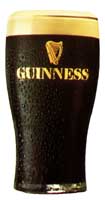
THE PERFECT PINT:

Note
the rich thick head. This is characteristic of a good pint of Guinness. The temperature
served should be between 5 and 8°C with a tight creamy head (10-15mm). The
pouring process is critical. If it's worth having, then it's worth waiting for.
The Guinness should be poured into a cool clean dry glass angled at around 45°.
Fill until 3/4 full and allow to stand until it settles. Then top up as per
the picture above. It is important that none of the Guinness runs down the side
of the glass. If the glass is topped up too much, then you will loose the head.
Without the head, the Guinness is like a toucan without wings! During
the drinking process, the head should maintain it's consistency, if not, then
there something wrong with either the Guinness or the glass. It is the generally
considered opinion, that Guinness served in the tapered Guinness glass as served
in most UK pubs, does not do justice to the head. The "tulip" style
is considered far better and in actual fact, this is the sort of glass used
in the Republic of Ireland.
THE ULTIMATE QUESTION:
A MYSTERY that has haunted pubs and perplexed drinkers for years has been solved by Australian scientists.
After spending hours staring into a pint of beer, both in the local pub and simulated within their computer, they think they now understand why the bubbles in a pint of Guinness appear to sink instead of rise.
Despite the common knowledge that bubbles float, drinkers over the ages have become struck by how a large portion of the bubbles move downwards within the dark brew. This troubling natural phenomenon has now been explained by simulation in a computer: large bubbles rise at the heart of the glass but small bubbles are dragged down near its periphery, the only part of the pint that is visible to the human eye.
Prof. Clive Fletcher, who, with students at the University of New South Wales in Sydney, has invested "hours of effort in pubs and bars" to explain the phenomenon, said: "With the help of computational fluid dynamics, we can provide a categorical and definitive answer: the bubbles go both up and down".
"Everyone familiar with hydrostatics, and having even a passing acquaintance with Archimedes, knows that gas bubbles are lighter than liquid and must experience a buoyancy force driving them ever upwards until they break out of their liquid prison."
His team simulated the motion of the bubbles using software from the international company Fluent, which has an office in Sheffield. The software could depict fluid flows, pressure, temperature, and chemical concentration in the pint at any location. Prof. Fletcher said: "Do 20 micron bubbles behave differently from one millimeter bubbles? Is the shape of the glass important? Yes, all of these factors and many others have a role to play."
In particular, Prof Fletcher's team used this software to simulate the motion of the bubbles and discovered that, as expected, most bubbles move upwards. Indeed, at the bottom of the glass, bubbles of all sizes want to rise. The bubbles in the centre of the glass, free from the effects of the wall, move upwards most quickly and drag liquid with them. But the liquid that moves upwards in the centre of the glass eventually turns towards the walls and starts to move downwards.
The liquid moving down near the walls tries to drag down bubbles with it. Larger bubbles have sufficient buoyancy to resist, respecting Archimedes. But smaller bubbles (less than 0.05mm) are continuously dragged to the bottom of the glass.
Dr Keith Hanna of Fluent Inc, in Evanston, Illinois, said: "From answering the perplexing Guinness riddle to helping design the escape vehicle for the International Space Station, computational fluid dynamics software is making it possible to gain a much better understanding of our environment. "Of course, the primary use of our software is solving far more serious fluid flow problems - optimising vehicle aerodynamics, speeding up the mixing process in chemical reactors, improving the performance of ventilation fans, that sort of thing."